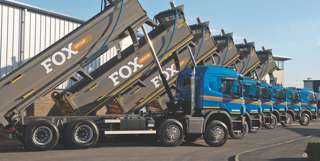Advertisement feature from AssetWorks
 Cutting edge fleet software is enabling fleets to integrate and aggregate multiple data streams, giving fleet operators unique tools to manage costs, meet sustainability goals and drive compliance
Cutting edge fleet software is enabling fleets to integrate and aggregate multiple data streams, giving fleet operators unique tools to manage costs, meet sustainability goals and drive compliance
The explosion in high value data available to fleet operators is placing unprecedented demand on fleet software systems.
Where legacy IT systems have traditionally focused on data input and output, state-of-the-art software is helping fleets to harness this rich tide of information by integrating and aggregating multiple data streams, said Mike Gadd, managing director of AssetWorks.
The company specialises in cloud-based fleet management solutions. By elevating fleet software from servers and terminals to the cloud, anyone in a business can access the system, which, in turn, can send alerts to all relevant decision-makers.
So if, for example, a driver or telematics system raises an alert about a warning light on a vehicle dashboard, the software can simultaneously notify the fleet, the workshop and operations managers, who can order relevant replacement parts, book the vehicle in for repair, and plan for it to be off the road.
Redcar & Cleveland Borough Council is one of many fleets to take advantage of this digitisation.
In a classic case of before and after, Gareth Healy, the council’s fleet manager, recalls how previously people would call the operations team to track their vehicle maintenance and see when the vehicles were ready for collection. Following the introduction of AssetWorks, however, staff can log in and see the process in real-time, without wasting time on the phone.
“The app technology enables inspections to be undertaken remotely, technicians to fix vehicles from anywhere and the operational managers can see what is being done and where in real-time,” said Healy.
The council offers a prime example of a wider industry shift towards mobilisation and digitisation, added Gadd.
“Information, not data, has always been our priority; our AssetAnalytics solution is the gateway to providing the support to agile decision-making based on well-presented and relevant intelligence.
“When you think about all the different data streams that are coming from wet and dry fuel management systems, electric vehicle (EV) technologies and adaptive technologies like artificial intelligence (AI), all of these are really data heavy.

“Older fleet management systems are failing in their data mining capability, leaving fleet managers unable to make the best-informed decisions.”
Being able to capture, access and manipulate multiple data sources is vital for fleets to contend with the plague of new vehicle shortages and lengthy delivery times. These are forcing fleets to walk the tightrope between sweating their existing assets as much as possible while minimising maintenance costs.
“Fleets are facing increasing tyre costs, soaring fuel costs, rising labour costs, as well as vehicle and parts shortages,” said Gadd. “Along with trying to embrace new technologies and industry-changing initiatives, they are being challenged to do more with the same or less resource.”
Mining data to support predictive maintenance schedules (based on AI forecasts of when components are likely to fail and replacing them beforehand) helps to avoid unscheduled vehicle downtime, while highlighting vehicles with the highest maintenance spend and greatest downtime, eliminates intuition and assumption when fleet managers prioritise which vehicles to replace.
By integrating APIs (application programme interfaces) from different data sources (parts suppliers, telematics systems, finance and leasing companies, fuel card operators, tyre manufacturers etc.) into fleet management software, fleets can fill their ‘data lakes’, and then create the data streams and rivers suited to their own unique requirements.
Royal Mail, for example, a long-standing customer of AssetWorks and the largest fleet in Europe, has saved thousands of pounds and hours of time in its workshops with a function that automatically flags failed parts still covered by warranty.
Some demands, however, are common to all fleets, and none more so than the rapid move towards zero-emission vehicles. With a client base of 500-plus fleets operating 14 million assets globally, AssetWorks is at the vanguard of fleet management software, providing clients with the tools required for a smooth transition to battery power.

Its Capital Asset Management tool enables fleet decision-makers to model the acquisition, disposal and replacement of all fuel and vehicle types, taking into account every element of wholelife cost, including charges to enter ultra-low emission zones, EV maintenance forecasts, while FuelFocusEV accounts for all EV charging sessions to measure overall energy consumption and spend.
“We are working with fleets on the complete EV ecosystem, including the ‘handshake protocol’ of how a vehicle communicates with the charging infrastructure, so clients can monitor which vehicle is drawing power, how often it is charging and how much electricity it is using,” said Gadd.
“We are also seeing the adoption of vehicle-to-grid technologies and battery capacities being factored into fleet replacement calculations, because fleets are recharging vehicles at off-peak tariffs and then selling back the electricity at peak times, which can be profitable. Large fleets with large capacity batteries are working out how to monetise their assets.”
While electrification is a preoccupation for fleets of all sizes and types, operators of heavy commercial vehicles also face the daily challenge of complying with operator licence rules and regulations.
The most ambitious truck fleets are now participating in the Driver and Vehicle Standards Agency (DVSA) ‘earned recognition’ scheme, which enables fleets to prove they meet driver and vehicle standards, and, in return, ensure their vehicles are less likely to be stopped for inspection.
A cursory glance at the 116 fleets that have so far joined the voluntary scheme includes names such as Wincanton, Sainsburys, the City of Wakefield, John Lewis and DPD.
Fleet software that replaces paper checklists with digital records of electronic daily driver first use checks and completed workshop jobs, and then automatically sends these key performance indicators (KPIs) to the DVSA in the correct format, is a massive aid to achieving and maintaining earned recognition status.
“Complying with regulatory compliance and safety standards are keeping fleet operators awake at night,” said Gadd. “Fleets can benefit from the standards of earned recognition even if they are not part of the scheme – our software helps keep them safe, compliant and on the road.”
![]() For more information please email communications@assetworks.com
For more information please email communications@assetworks.com
or visit our website here

















Login to comment
Comments
No comments have been made yet.